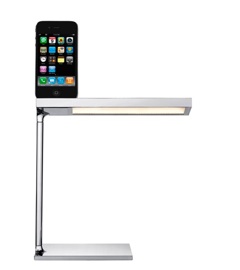Our gadgets dictate the future of furniture design

But now our everyday technology, which is increasingly becoming consolidated on hand-held devices and tablets, is pushing both consumers and designers to re-think the landscape of furnishings.
Writing in the New York Times on March 28, Steven Kurutz discussed this trend with a variety of leading designers, including Philippe Starck and Yves Behar. They focused on how companies are creating furniture to accommodate smart phones and PCs in their various forms.
“The rate of technological change has gotten so fast that we need to inform the design to reflect it,” Ryan Anderson, director of future technology for Herman Miller--the legendary furniture maker known for manufacturing pieces by Charles and Ray Eames--said to Kurutz.
"In decades past...designers had time to anticipate where technology was headed and to plan for it," Kurutz wrote. Today, they have to work in real-time, designing to accommodate new gadgets "almost instantly" to make tables, lights, and desks seem relevant to potential buyers.

Starck has designed, for chic lighting maker FLOS, a slick-looking $396 lamp that includes a built-in dock for Apple's iPhone, iPad, and iPod. Jonas Damon, a creative director at frog, has become well-known for designing a witty iPhone dock that has the basic lines of an analog alarm clock. And (although the article doesn't mention it) Herman Miller's newest desks and tables for homes, offices, and schools often come with hidden "troughs" to hide power adaptor chords or actual outlets built into them.
Herman Miller hired Anderson very recently, Kurutz reported, to help the company predict how to design future seats, work surfaces, and other products as the technology landscape evolves. One can imagine the questions he tackles: What happens when people sit less and less at desks--what are their furniture needs? How will tablet computing influence how and where people work and type? It seems to me as if the deeper question Anderson must be facing is this: how does a company that has sold furniture made to accommodate 20th-century technology evolve in the 21st century?
Kurutz's piece includes observations from Starck, Behar, and Karim Rashid on the future of furniture. Rashid looks forward to "upholstery that reacts to temperature, tiny speakers built into seating, and wallpaper embedded with liquid crystals that turn a wall into a giant TV screen," Kurutz reported. Behar predicts more modular furniture that can be mixed and matched, with outdated pieces swapped out for new ones that incorporate new technologies as they are released. And Starck imagines that eventually, people will become "bionic." He foresees that we'll be embedded with microchips that turn us into devices ourselves. So shelves and other furniture will become...well, obsolete.
In many ways, the sci-fi future Starck describes reflects contemporary designers'--and technologists'--ultimate design goals. Obviously, one is simplicity. And another is a user interface that is utterly intuitive.
Images: Classroom desks with power outlets, Herman Miller; D'E light, Flos USA
This post was originally published on Smartplanet.com
